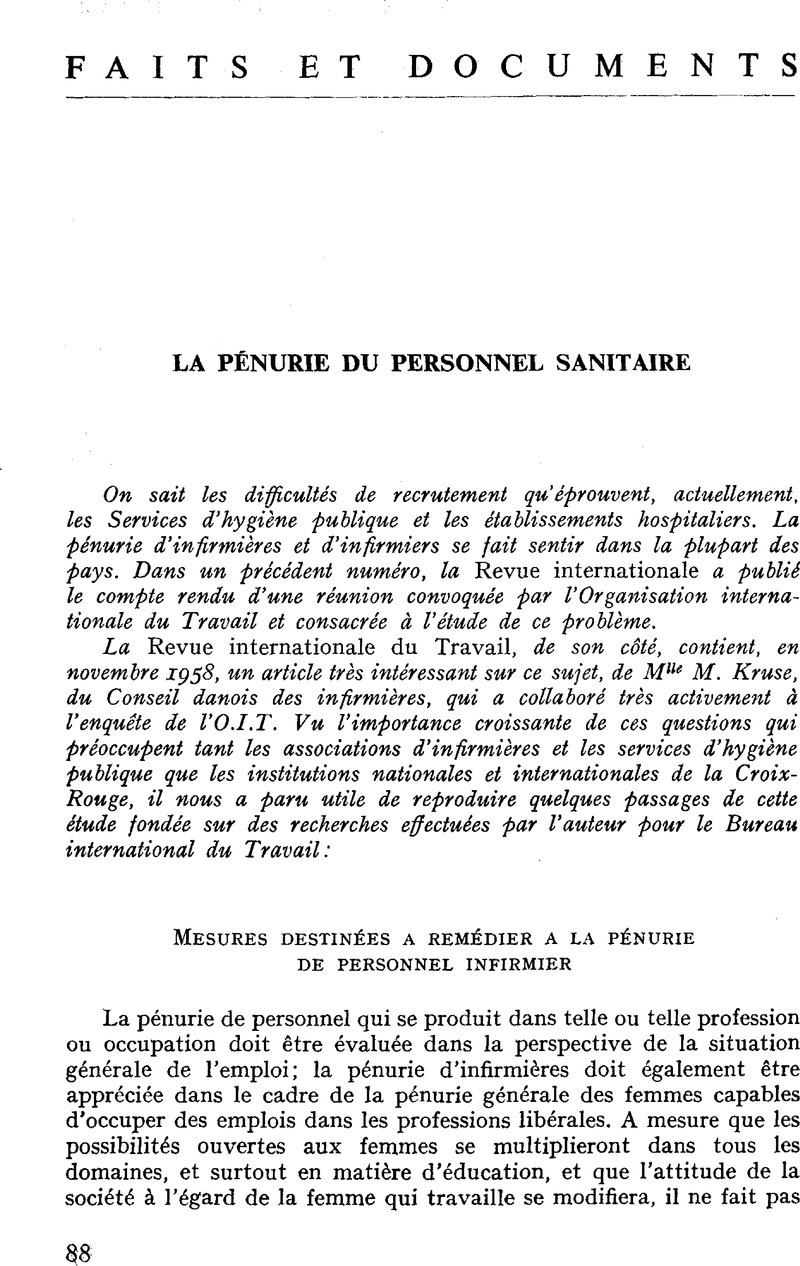No CrossRef data available.
Article contents
La pénurie du personnel sanitaire
Published online by Cambridge University Press: 19 April 2010
Abstract

- Type
- Faits et Documents
- Information
- Copyright
- Copyright © International Committee of the Red Cross 1959
References
page 89 note 1 O.M.S. : A9/Discussion technique 4/Groupe 2 (mai 1956), p. 3.
page 90 note 1 O.M.S. : Comité d'experts des soins infirmiers : Rapport sur la première session, op. cit., 9.
page 92 note 1 Le Comité des soins infirmiers de l'Inde a insisté sur ce point dans un rapport où il étudie les conditions de service du personnel infirmier (Government of India, Ministry of Health : Report of the Nursing Committee to Review Conditions of Service Emoluments, etc. of the Nursing Profession, New-Delhi, 1955, p. 33).Google Scholar
page 94 note 1 Voir, par exemple, American Nurses' Association, Public Health Nursing Section : Functions, Standards and Qualifications for Public Health Nurses (New-York, 1955), P. 4.Google Scholar
page 95 note 1 Voir, par exemple, Ministry of Health, Department of Health for Scotland, Ministry of Education : An Inquiry into Health Visiting. Report of a Working Party on the Field of Work, Training and Recruitment of Health Visitors (Londres, H.M. Stationery Office, 1956), pp. 103–105.Google Scholar
page 95 note 2 D'apres le rapport intitulé : Report of the Nursing Committee to Review Conditions of Services, Emoluments, etc. of the Nursing Profession in India, op. cit., « l'infirmière-visiteuse qui est seule à desservir une population de quelque 40.000 à 60.000 âmes ne peut guère apporter de contribution appréciable à l'hygiène publique. Elle ne retire que peu de satisfaction morale à travailler dans ces conditions, et l'incapacité où elle se trouve d'accomplir un travail convenable finit par engendrer l'indiffèrence ».
page 95 note 3 Voir Conférence Internationale du Travail, 42me session, Genève, 1958, Rapport VI (1) : L'organisation des services de médecine du travail dans l'entreprise (Genève, B.I.T., 1957).Google Scholar
page 96 note 1 Ibid., p. 23. Voir aussi Cecily Pike, F. : « A South African Experiment », The South African Nursing Journal, vol. XXI, no8, août 1955.Google Scholar
page 98 note 1 Les questions relatives au personnel auxiliaire d'infirmerie sont traitées plus en détail dans O.M.S., Comité d'experts des soins infirmiers: Rapport sur la première session, op. cit.; dans Idem : Educ/85, oct. 1955; et dans R. M. Morris : Auxiliary Personnel, Assignments and Conditions of Work (Expert Committee on Professional and Technical Education of Medical and Auxiliary Personnel).
page 98 note 2 Voir O.M.S., : Recueil international de législation sanitaire, Législation sanitaire comparée : Soins infirmiers (Genève, 1958).Google Scholar


